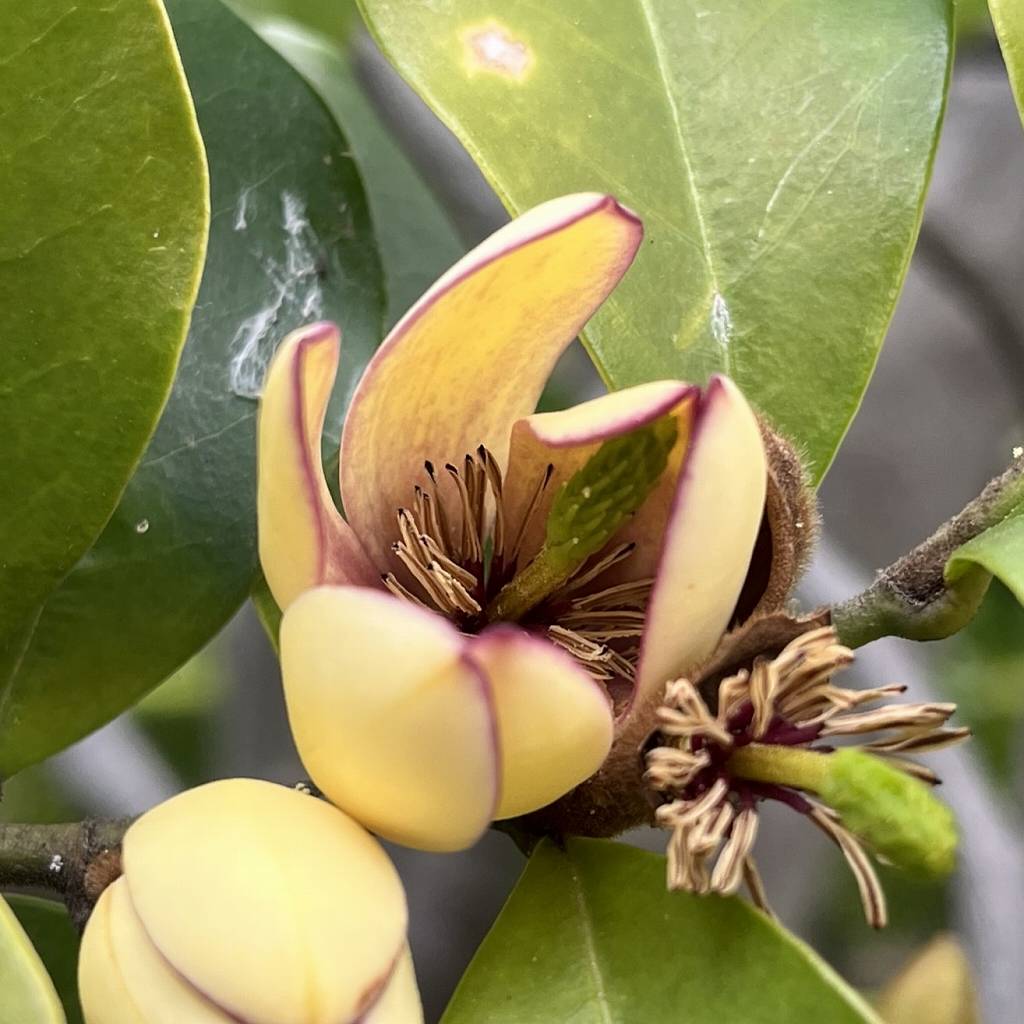カラタネオガタマの名前は「中国原産で精霊を招く木」という意味。花はバナナのような爽やかな芳香を漂わせます。花言葉も「甘い誘惑」。
Japanese name of Banana Shrub means “a tree native to China that invites spirits”. The flowers have a refreshing fragrance like bananas. The flower language is also “sweet temptation”.
【仮名】カラタネオガタマ
【和名】唐種招霊
【英名】Banana Shrub, Banana Magnolia
【学名】Magnolia figo
【誕生】05/ 12, 05/ 19
【開花】04, 05, 06月
【花色】White, Pink, Red, Yellow



カラタネオガタマ
カラタネオガタマの概要
カラタネオガタマはモクレン科の常緑小高木です。原産地は中国南部で、日本へは江戸時代に渡来。在来種「招霊木」に準ずる外来種として神社に、芳香を放つ花木として庭園に植えられました。寒さに弱いため、関東より北では鉢植えし、屋内で冬越し。花言葉は「甘い誘惑」です。
カラタネオガタマの名前
カラタネオガタマの名前の由来は中国(唐)が原産(種)の「招霊」です。招霊木は日本在来の近縁種。古くから神聖な木とされ、天照大神が隠れた天岩戸の前で、天鈿女命がその枝を手にしながら舞いました。今も「精霊を招く木」として神社に植栽。その葉が神事に用いられます。
カラタネオガタマの姿形
カラタネオガタマは灰色の幹に縦皺が入り、枝に褐色の毛が密生。葉は長楕円形で互生し、表面に光沢があります。花は肉厚の花冠が半開し、黄白色の花被片6枚に紅紫色の縁どり。真ん中に黄緑色の雌しべが立ち、多くの雄しべが囲みます。花後の集合果は熟すと裂けて種子が露出。
カラタネオガタマの近縁
カラタネオガタマの品種「ポートワイン」は花が赤褐色、「パープルクイーン」は暗赤色。変種「スキネリアナ」は花が乳白色、「クラシペス」は桃色です。近縁種「招霊木」は花が黄白色で基部が紅紫色。花被片が12枚と多く、花の匂いが強いものの、主成分は安息香酸メチルです。
カラタネオガタマの芳香
カラタネオガタマの花はバナナの香気に似ている甘く爽やかな芳香を漂わせます。そのため、英名も「バナナの低木」など。匂いの主成分はバナナと同じ酢酸イソブチルです。芳香が人々に笑顔をもたらすことから、中国名は「含笑花」。台湾では首飾りや髪飾りなどに用いられます。
Banana Shrub
Banana Shrub is an evergreen small tree of the Magnoliaceae family. It originated in southern China and was introduced to Japan during the Edo period. It was planted in shrines as a non-native species similar to the indigenous species “Magnolia compressa”, and in gardens as a fragrant flower tree. Since it is vulnerable to cold, it is potted in the north of Kanto and overwintered indoors. Flower language is “sweet temptation”.
Japanese name of Banana Shrub means “Magnolia compressa” which is native to China. Magnolia compressa is a closely related species native to Japan. It has been considered a sacred tree since ancient times, and in front of Amanoiwato, where Amaterasu Omikami hid, Amanouzume no Mikoto danced while holding a branch. Even today, it is planted at shrines as a “tree that invites spirits.” The leaves are used in Shinto rituals.
Banana Shrub has a gray trunk with vertical wrinkles and densely brown hairs on the branches. The leaves are oblong, alternate, and have a glossy surface. The flower has a thick corolla half-opened, and has 6 yellowish-white petals with a reddish-purple rim. A yellow-green pistil stands in the middle, surrounded by many stamens. When the aggregate fruit after flowering ripens, it splits and the seeds are exposed.
The cultivar “Port Wine” of Banana Shrub has reddish brown flowers, and “Purple Queen” has dark red flowers. The variety “Skinneriana” has milky white flowers, while “Crassipes” has pink flowers. The closely related species “Compressa” has yellowish-white flowers with reddish-purple bases. It has 12 tepals and has a strong floral scent, but the main component is methyl benzoate.
The flowers of Banana Shrub have a sweet and refreshing fragrance similar to that of bananas. The main component of the smell is isobutyl acetate, which is the same as bananas. The Chinese name of it means “flower with a smile” because the fragrance brings smiles to people. In Taiwan, it is used for necklaces and hair ornaments.


